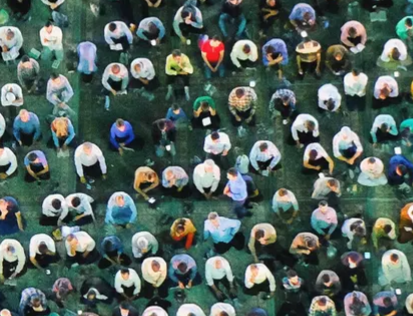While the pandemic has made exceptional demands of us, even before the Covid-19 lockdown, crowds have been under threat.
尽管流行病对我们提出了特殊要求,但甚至在因新冠病毒禁闭之前,人群聚集就已受到威胁。
We were becoming ever more atomised, and pushed further into our homes,
我们变得越来越分散,越来越深入自己的家园,
and crowds were becoming more domesticated, enclosed, surveilled and expensive to be a part of.
人群变得越来越喜欢家庭生活、封闭、监视,加入其中也越来越昂贵。
Our opportunities to gather freely, in both senses of the word, have greatly diminished since the 90s.
自90年代以来,我们自由聚集的机会,无论从何种意义上说,都大大减少了。
And yet, throughout human history, there has always been something pleasingly resilient about the crowd:
然而,纵观人类历史,人群总是有一些令人愉快的复原力:
however many new ways are found to disperse it, it will always find a way to reconvene.
无论找到多少新的方法来使人分散,人们总会找到重新集会的方法。
Crowds have always had a bad rap: there is no gentle mob, no friendly pack.
人群总是有不好的名声:不温和的暴徒,不友好的群组。
The same disinhibition that allows for moments of great joy can also enable grotesque crimes.
释放压抑,给我们带来巨大的快乐,同样也会让我们犯下荒唐的罪行。
The people who gathered to watch lynchings in the US, or recent attacks on Muslims by groups of Hindu nationalists in India,
在美国,有人聚集在一起观看私刑。最近在印度,印度教民族主义者团体袭击了穆斯林。
were not just bystanders but participants. Their presence and acquiescence helped make the violence possible.
他们不仅是旁观者,而且是参与者。他们的存在和默许使得暴力成为可能。
And just as the people at the back of the crowd empower those at the front, the reverse can be true.
就像后排的人给前排的人力量一样,情况也可能正好相反。
The hooligan firm leader who throws the first cafe chair across a moonlit plaza on a balmy European away day
在一个温暖的欧洲旅行日,一个流氓公司的领导在洒满月光的广场上放出了第一把咖啡椅,
makes it easier for more timid members of the crowd to cross their own "cooperation threshold" and join in.
使得人群中更胆怯的成员更容易跨越他们自己的“合作门槛”并加入进来。

Even celebratory or worshipful crowds can go wrong, and when they do, they generate an unmatched horror.
即使是欢庆或虔诚的人群也可能出乱子,当他们出乱子时,就会带来无与伦比的惨状。
Few things strike fear like the the idea of mass panic, few words as chilling as "caught up in a stampede" or "trampled to death".
没有什么比集体恐慌更让人恐惧的了,也没有什么比“被踩踏”或“被踩踏致死”更让人不寒而栗的了。
The horror of the 96 dead at Hillsborough in 1989, or the 21 suffocated at the 2010 Duisburg Love Parade,
1989年希尔斯堡惨案造成96人死亡,2010年杜伊斯堡爱大游行造成21人窒息,
or the 2,400 killed in a crowd collapse at the 2015 Hajj, gnaws at something deep in our psyches.
或者2015年朝圣人群倒塌导致2400人死亡的事件,这些恐惧侵蚀着我们内心深处的某些东西。
For some people, even a peaceful and orderly crowd can be scary, triggering intense anxiety or PTSD.
对一些人来说,即使是平和有序的人群也会让人害怕,引发强烈的焦虑或创伤后应激障碍。
Informed by tragedies, uprisings and protests alike, for a long time crowds were seen as inherently dangerous and lobotomising.
在很长一段时间里,人们被悲剧、起义和抗议活动所影响,人群被认为天生就危险,需要进行脑白质切除术。
But during the past couple of decades, thanks to work by social psychologists, behavioural scientists and anthropologists,
但在过去的几十年里,由于社会心理学家、行为科学家和人类学家的工作,
a new understanding of the complexity of crowd behaviour has become increasingly influential.
一种对群体行为复杂性的新理解已经变得越来越有影响力。


